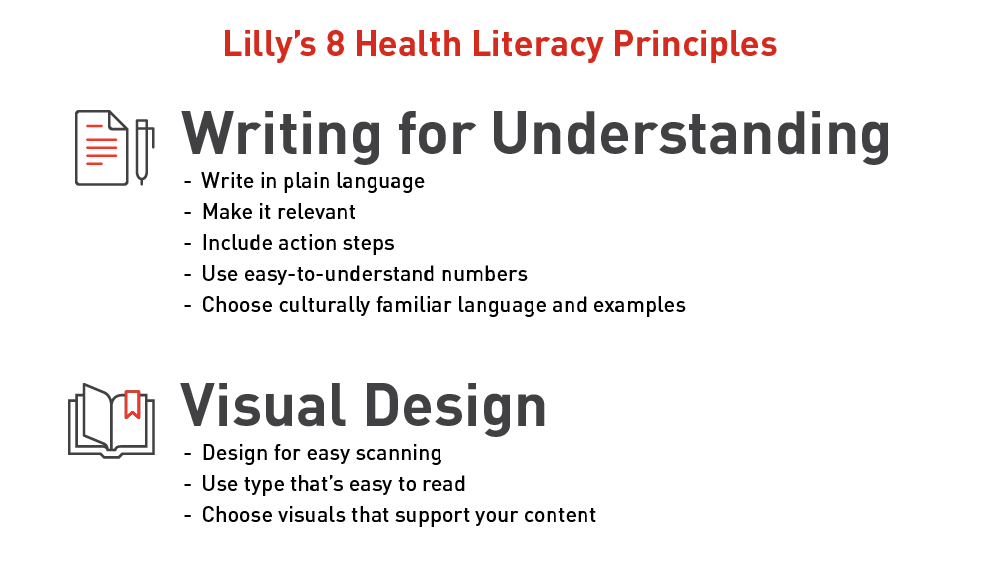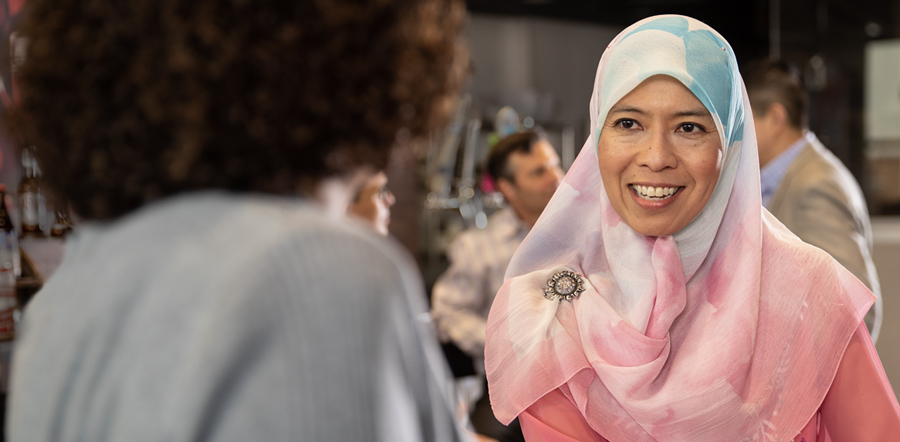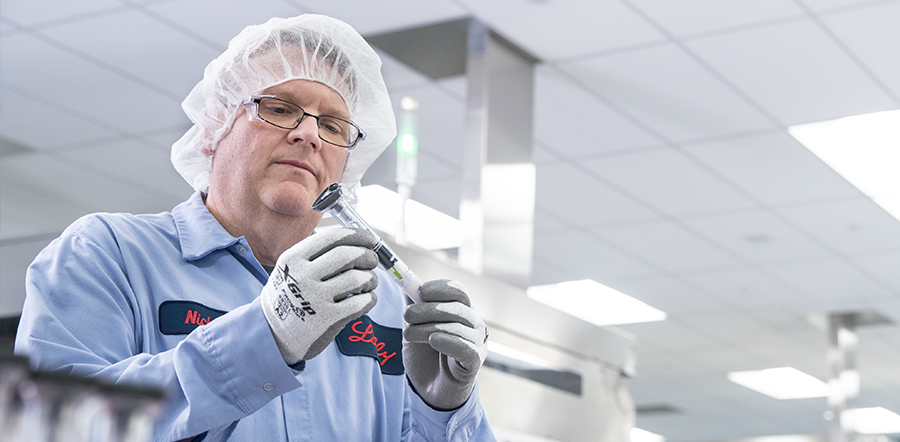U.S. Access & Affordability
Management Approach
Throughout our nearly 150-year history, Lilly has pioneered many life-changing medicines – including insulin, which has helped make diabetes a manageable disease; penicillin, which greatly reduced deaths from infection; fluoxetine, which revolutionized depression care; and COVID-19 treatments, which provided additional tools in the fight against the global pandemic. Today, an estimated 51 million people use Lilly’s medicines.
Lilly employees from across the globe come together from diverse backgrounds to push the limits of science to develop novel treatments for millions of people with serious illnesses. We invest in innovation that helps solve some of the world's most significant health challenges.
But we know that our commitment to patients and society goes beyond the medicines we make.
We are deeply committed to equitable and affordable access to our medicines so that our breakthroughs can transform more people’s lives. We’re also committed to expanding our impact on society by addressing complex global health challenges, with a focus on people living in communities with limited resources.
Reaching across industry boundaries, we collaborate with leading partners to reach more people and help them feel better in their daily lives. Our collective work benefits individual patients and the entire global health system.
Pricing in the U.S.
Pricing medicines to achieve the optimal balance between patient access and sustained investment in innovative treatments is complex. At Lilly, we know that pricing our medicines is one of the most important decisions we make as a company. When making pricing considerations, we use a value-based approach, taking into account the following:
Customer perspective – The unmet needs that medicines can fulfill for patients and caregivers and how people can affordably access the treatment.
Company considerations – The costs of research, development, manufacturing and support services for customers; business trends and other economic factors; and the medicine’s potential market size, patent life and place within our larger portfolio of medicines.
Competitive landscape – The benefits of our medicine compared to alternative medicines, where our medicine fits in treating conditions and existing contracts between payers and our competitors.
Contributing factors – Such as health system changes and policy guidelines.
Lilly also makes price adjustments over a product’s lifecycle that are based on the factors above as well as improvements in the clinical data supporting the drug’s use.
We are committed to increasing transparency around the price of our medicines. We publish list prices for our medicines, as well as average out-of-pocket costs and financial assistance information.
List Price vs. Net Price
A list price for each of our medicines is set using the considerations noted above.
We pay rebates and other discounts to payers, pharmacy benefit managers (PBMs), the U.S. government and other supply chain entities such as wholesalers and distributors. After paying these rebates, discounts and channel costs, the final dollar amount that Lilly ultimately receives is called the net price.
These rebates and discounts have continued to grow over the years for Lilly’s entire U.S. portfolio while net prices for many of our medicines have continued to decrease.
Lilly U.S. Affordability Solutions
Success is helping people heal – and we understand that developing lifesaving medicine is only the start of the conversation. At Lilly, we work to improve access to our treatments and increase equity throughout the healthcare system. We actively advocate for and participate in the process of driving systematic changes.
We support the restructuring of financial incentives for the entire pharmaceutical supply chain to ensure patients directly benefit, at their point of purchase, from the rebates and discounts we provide to pharmacy benefit managers, payers and others. We are also taking important steps within our own control to increase access to Lilly medicines today.
Lilly offers a variety of affordability solutions through patient support programs and copay assistance across the major products of our portfolio, including medicines for diabetes, migraine, immunology diseases and cancer. For migraine and immunology, we’ve designed copay assistance programs to bring eligible patients’ monthly out-of-pocket costs to as little as $25 or lower. For diabetes and cancer, we have created a Lilly Diabetes Solution Center and a Lilly Oncology Support Center that assist eligible patients in identifying affordability options related to their Lilly treatment.
Insulin Affordability
For millions of people with diabetes, insulin is a life-saving medicine. Over the last century, this medicine has improved and extended countless lives around the world. Lilly takes its role as a leading diabetes company seriously – and that includes ensuring people have affordable access to insulin therapies.
While many people in the U.S. have insurance coverage with affordable copays, some struggle to afford their out-of-pocket costs for insulin. Some people have large deductibles they must satisfy before insurance will cover their medicines, while others have no insurance at all. And, for many people, insulin is just one of several interventions used to control diabetes, such as blood glucose monitoring devices and supplies and other medicines.
In recent years, Lilly has introduced multiple insulin affordability solutions. As a result of our efforts, anyone is eligible to buy their monthly prescription of Lilly insulin for $35 or less, regardless of the number of pens or vials they use, and whether they are uninsured or use commercial insurance, Medicaid or are enrolled in a Medicare Part D plan.*
These insulin affordability solutions include:
In 2019, we introduced a non-branded insulin, Insulin Lispro, at half the list price of branded Humalog. Insulin Lispro, which is the same molecule as Humalog, is now 70% off the list price of its branded counterpart, after an initial price reduction.
In 2020, we announced the Lilly Insulin Value Program, a savings card allowing people with commercial insurance or those who are uninsured to buy their monthly prescription of Lilly insulin for $35.
In 2021, we committed our full portfolio of insulins to the Medicare Part D Senior Savings Model, allowing seniors enrolled in participating Part D plans to purchase their monthly prescription of Lilly insulin for $35 during all phases of their Part D coverage. With the passage of the Inflation Reduction Act (IRA), the program will sunset at the end of 2023.
Under the IRA, more than 3 million Medicare beneficiaries who take insulin will pay $35 per month or less on their insulin. Lilly was a strong supporter of this provision as it aligns with the affordability solutions we’ve had in-place years before the IRA became law.
In 2023, we announced additional steps to make it even easier for people to access Lilly insulin:
Effective in March, we implemented an automatic cap to limit out-of-pocket monthly cost to $35 for people with commercial insurance at participating retail pharmacies.
Effective in April, we launched a biosimilar basal insulin at a lower list price.
Effective in May, we cut the price of our Insulin Lispro vials to $25 a vial, making it the lowest list-priced mealtime insulin available.
Effective in the fourth quarter, we will reduce the list price of our most commonly prescribed insulins by 70%.
All of these programs are already making an impact, helping people fill more than 100,000 prescriptions for Lilly insulin each month. Importantly, despite rising insurance deductibles, the average monthly out-of-pocket cost for Lilly insulin has dropped to $20.48.
* Terms and conditions apply. Automatically applied at the majority of retail pharmacies for those with commercial insurance. Government restrictions exclude people enrolled in federal government insurance programs from Lilly's $35 solutions. But federal law provides that Medicare Part D beneficiaries also pay no more than $35 per month for insulin.
Our suite of affordability programs is available on insulinaffordability.com and through the Lilly Diabetes Solution Center at (833) 808-1234. The Solution Center is a call center staffed with experts who can help guide individuals to the affordability solution that best matches their needs, including connecting people with diabetes to charitable organizations that provide free Lilly insulin. Additionally, we are a financial supporter of getinsulin.org, a tool launched in 2020 by the patient advocacy group, Beyond Type 1, that helps people easily find the most affordable insulin options in their area – regardless of brand or manufacturer. Both web- and app-based, getinsulin.org is a convenient one-stop shop for people who use insulin and is available in both English and Spanish.
These solutions are only helpful if people know about them, and Lilly has worked diligently to make people aware of their options. We have published full-page advertisements in dozens of top English and Spanish-language newspapers to inform Americans how they can lower their insulin costs. We have also published sponsored content and ads online, and participated in radio and TV station interviews about Lilly’s affordability solutions in markets throughout the U.S to increase awareness about our affordability solutions.
Explore our Social Goals and Progress
See important information about our ESG report.







